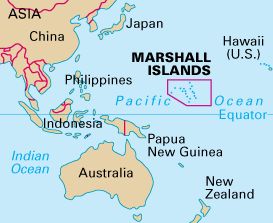- Home
- Prelims
- Mains
- Current Affairs
- Study Materials
- Test Series
 EDITORIALS & ARTICLES
EDITORIALS & ARTICLES
Marshall Islands
 The Republic of the Marshall Islands (RMI) is situated nearly midway between Hawaii and the Philippines.
The Republic of the Marshall Islands (RMI) is situated nearly midway between Hawaii and the Philippines.- It is the easternmost island group in Micronesia.
- The country consists of two parallel chains of atolls and islands in the central Pacific Ocean, known as the Ratak (Sunrise) chain and Ralik (Sunset) chain.
- It is a chain of five volcanic islands and 29 coral atolls in the Pacific Ocean, between Hawaii and the Philippines.
- It is comprised of approximately 1,225 islands and islets
- The Marshall Islands uses the US dollar as its currency.
Government:
- It is a presidential republic with a parliamentary system.
- The President of the Marshall Islands is both the head of state and the head of government.
Economy: Agriculture and tourism are the mainstays of the economy.
- Strategically, Marshall Islands hosts the US Army Kwajalein Atoll (USAKA) Reagan Missile Test Site, a key installation in the US missile defence network.
- Marshallese citizens can work and study in the US without a visa, and they join the US military at a higher rate than any US state.
History:
- The islands have been under the control of various nations throughout the last few centuries, including Spain from the late 1400s to the late 1800s, Germany from 1885 to World War I, and Japan from 1914 to World War II.
- After World War II, the RMI became a part of the United Nations (UN) Trust Territory of the Pacific Islands under the United States (US) administration.
- The RMI Government was officially established in 1979, following the signing of the Constitution.
- The RMI gained its independence in 1986 after signing the Compact of Free Association with the US, ending the UN-US Trusteeship Agreement.
The Compacts of Free Association (COFA)
- It governs the relationships between the US and the Republic of the Marshall Islands, Federated States of Micronesia, and Republic of Palau known collectively as the Freely Associated States (FAS).
- The governments of the Marshall Islands and Micronesia signed Compacts of Free Association (COFA) with the United States in 1982.
- It granted the Marshall Islands financial assistance and access to many US domestic programmes in exchange for exclusive US military access and defence responsibilities.
Pacific Ocean
- It is the largest ocean in the world.
- It has an area of 165, 246, 200 sq km which is about one-third of the earth’s surface area.
- This vast ocean has an area which exceeds the total land area of the world. It stretches to over 16,000 km along the equator.
- It is 14,880 km from Bering-Strait in the north to Cape Adre of the Antarctic continent in the south.
- It has a significant impact on global climate patterns through phenomena like El Niño and La Niña.
- It hosts several major ocean currents, including the North Pacific Current, the California Current, and the South Equatorial Current.
The Pacific Island Countries (PICs)
- It is a cluster of 14 island nations dotting the Southwestern Pacific: the Cook Islands, Fiji, Kiribati, the Marshall Islands, Micronesia, Nauru, Niue, Samoa, the Solomon Islands, Palau, Papua New Guinea, Tonga, Tuvalu, and Vanuatu.
- All these islands are located at the crossroads of strategically important maritime trade corridors.
- Of the 14 PICs, Fiji and Papua New Guinea (PNG) are the ones with the biggest populations and the most heft.
- It consists of the three major groups of islands: Melanesia, Micronesia and Polynesia.
- These countries face common challenges such as climate change, sustainable development, limited resources, and vulnerability to natural disasters.
Corals
- They are invertebrate animals belonging to a large group of colourful and fascinating animals called Cnidaria.
- Each coral animal is called a polyp, and most live in groups of hundreds to thousands of genetically identical polyps that form a ‘colony’.
- The colony is formed by a process called budding, which is where the original polyp grows copies of itself.
- These polyps have microscopic algae called zooxanthellae living within their tissues.
- The corals and algae have a mutualistic relationship. The coral provides the zooxanthellae with the compounds necessary for photosynthesis.
Atolls
- They are formed on mid-oceanic ridges.
- They are shaped circularly or elliptically and are surrounded by seas on all four sides and have shallow waters in the center called a lagoon.









 Latest News
Latest News General Studies
General Studies